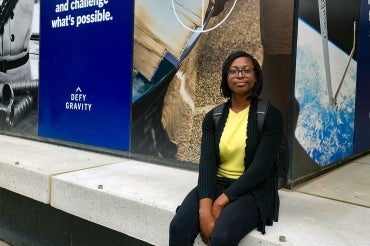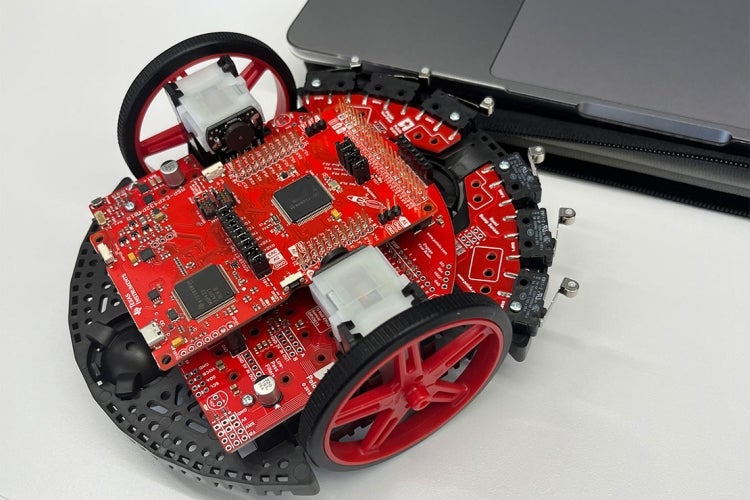U of T Engineering program introduces Black high school students to STEM careers

Jadesola Babalola-Lucas, 16, explored her passion for engineering during U of T Engineering's Blueprint program last summer (supplied image)
Published: February 12, 2024
Jadesola Babalola-Lucas, 16, has felt an affinity for math and science since she was in elementary school, but it was not until the summer of 2020 that she discovered her passion for engineering.
“I was stuck at home because of COVID-19 and watching a lot of TV, especially the Smithsonian Channel,” says Babalola-Lucas, who is now in Grade 11. “And I kid you not, I had an epiphany watching Planes That Changed the World.”
She was struck by aeronautical feats involved in the design of aircrafts such as the Lockheed SR-71 Blackbird, the fastest crewed aircraft with air-breathing engines, and the way the engineers overcame their challenges with creativity.
“I began to understand how interdisciplinary engineering really is, and it was at that moment that I realized engineers really do make the world go round,” says Babalola-Lucas. “Who wouldn’t want to be a part of something that big?”
A few years later, Babalola-Lucas stumbled upon a posting for Blueprint, an academic enrichment program run by the University of Toronto’s Faculty of Applied Science & Engineering for Black high school students who are passionate about science, technology, engineering and math (STEM). She could not pass up the opportunity to apply and step closer to her goal of studying either materials science or mechanical engineering, and then pursuing graduate studies in aerospace engineering.
The free, four-week Engineering Outreach program, which is taking applications for this summer until March 24, introduces students who have just finished Grades 10 and 11 to the engineering design process. Through course offerings, hands-on activities and collaborative projects, participants apply what they have learned to create innovative solutions for global issues.
Students are also connected with mentors, who are current undergraduate engineering students – some of whom have gone through the Blueprint program themselves. The mentors help participants understand the day-to-day experience of studying STEM subjects in university.
Blueprint students continue their engagement with U of T Engineering over the next school year through two programs – Prepare for Grade 11 students and My Academic Planning Sessions (MAPS) for Grade 12 students. From October through March, weekly virtual sessions guide the prospective university students through the obstacles they may face during their transitions from high school to university.
Additionally, Blueprint participants who are accepted into a U of T Engineering undergraduate program are eligible to receive one of five fully funded entrance scholarships that is renewable for four years.
“Blueprint allows Black students to meet successful individuals with similar racial and academic backgrounds. We do this by inviting Black STEM professionals and current engineering students as guest speakers over the summer and yearlong engagement,” says Cassandra Abraham, a co-ordinator at Engineering Outreach and Blueprint director.
“This representation can be empowering, instilling a sense of belonging and motivating students to pursue STEM careers.”

The program is structured to facilitate connection among peers. Students are initially divided into groups based on their hobbies and interests – information that is collected during the onboarding process – to encourage them to communicate with each other and form friendships, says Abraham.
When Shenile Ellis, 17, first applied to Blueprint, the then-Grade 11 student thought it would be a great opportunity to learn more about different engineering disciplines.
While she was already interested in mechanical engineering because she enjoyed 3D modelling and seeing projects come to life, she was keen to meet other Black students who were interested in STEM and get a glimpse of what it is like to learn on a university campus.
“I wasn’t sure I would get in, but when I did, I realized I should never count myself out,” Ellis says. “One of the Blueprint leaders always told us that we were there for a reason and that we are all capable.”
For Christine Martins-Ezeifeaku, 17, some of the most memorable moments from the summer were the hands-on activities that were a part of the two courses: Engineering and Human Health, and Mechatronics and Automation.
“In the biomedical engineering lab, we got to do many things we wouldn’t have had the opportunity to do in a typical high school experience,” Martins-Ezeifeaku says. “We got to diagnose sickle cell anemia and create E. coli bacteria.
“Getting to code the robots in the mechatronics lab and seeing them move after we finished was also an amazing experience.”
Martins-Ezeifeaku, who has always gravitated towards working with computers and sees herself studying computer engineering or computer science at university in the fall, says she knows how important it is to see people like herself in the technology field.
“In Grade 10, I took a computer science course that was taught by a teacher who is a Black woman and I was surprised at first because I wasn’t expecting her,” she says. “I loved that class; it really sparked my interest.
“Everyone who has helped me work towards the technology field has been really encouraging.”
As part of a month-long engineering design challenge, Blueprint participants were placed in groups and tasked with designing a solution to a client’s problem. This culminated with a presentation in front of judges, U of T Engineering Dean Chris Yip, graduate students and family members at the Myhal Centre for Engineering Innovation & Entrepreneurship.
“I really enjoyed the project because it allowed me to work on my presentation and teamwork skills,” says Ellis. “The experience also gave us experience that we could use in a first-year engineering design course.”
Babalola-Lucas, meanwhile, was part of a team tasked to create a product that repelled locusts on a farm in Jamaica. Together, they designed and built an ultrasonic 40 kHz speaker with a high-enough frequency to disrupt the locusts, but too high for humans to hear – so it didn’t affect human quality of life or wildlife.
“It was really innovative for us, and we ended up winning the competition, which was an extraordinary moment for me,” Babalola-Lucas says. “The entire experience was also an important lesson because I learned that no engineer works alone. You need to know how to work with anyone and everyone. You need to know how to collaborate. Blueprint taught me that from day one.
“I think any Black student who knows they love STEM should join Blueprint. You’re not only going to be exposed to the different disciplines within engineering, but you’re also going to experience a taste of campus life and learn how to study like a university student. You won’t regret it.”



